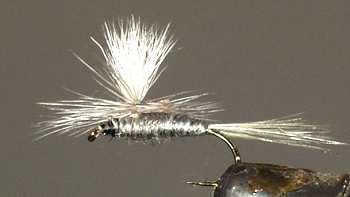The Blue Dun Parachute Dry Fly
The Blue Dun Parachute Dry Fly pattern has taken many trout for me, particularly early in the season. It imitates Iron Blue Insects (Baetis niger, Baetis muticus or Baetis pumilus). Trout have a great liking for this little fly.

PARACHUTE EMERGER DRY FLIES. Hook size 12 14 16 18 20 24 - $US each
It is commonly believed that Iron Blue Duns hatch only on wet, windy days. This is not true as I have seen numerous hatches in calm warm conditions. It is easy to spot as it is the only upwinged fly that has such an overall dark body color. It hatches during the summer with peaks at the beginning and end of summer. It emergers at the surface in open water during the day in irregular, sometimes prolific, hatches. The Blue Dun is not an evening fly. They tend to swarm during the day. Mating and egg laying also often takes place during the day. This fly can be used as a good imitation of the Claret Dun (Leptophlebia Vespertina). They emerge late spring and prefer stillwater or slow flowing streams. The female and male are similar.
I like to use parachute dry fly patterns on smooth pools and lakes. I find in good visibility situation’s the silhouette stands up better to closer inspection by trout and grayling. I carry a selection of colours and sizes in my fly box to cover emerging dun mayfly as well as spent spinners who have fluttered back on the water just before they die.
Many times I have covered a rising fish with a dry fly fully expecting a take, only for to look on with disappointment as the fly is refused and the fish turns away. A change to a different fly pattern normally does the trick if you can work out what caused the first one to be refused. A standard dry fly is designed to sit on the surface of the water to represent an emerged dun mayfly drying its wings before going airborne. It can also imitate a female laying eggs or a spent spinner. Fly patterns like the parachute are designed to sit in the surface film and provide a better imitation of the dun hatching. This may be the shape in the water that the trout was looking for.
I know all the top advice is to match the hatch exactly but I was given a tip to tie on a slightly larger imitation fly during times of very heavy hatches. Trout will sometimes pick this offering out in preference to the natural insects. This does not always work but it can produce results to fish in a target rich environment. Try flies that are the same size as the ones floating on the water surface first. If you get no results then that is the time to try a large hook size.
If you are witnessing a hatch and the fish are not taking your dry flies that match the natural insects in size colour and shape try using a very fine seine-net and skim the surface. You may be surprised to find spinners. You may not have been able to see them because of their low profile on the water, many are flat and some are drowned and water logged. Armed with this new knowledge. A team of lightly dressed and greased soft hackle wet flies fished in the surface on a drift over the rising trout can bring good takes.
Fly Fishing books

